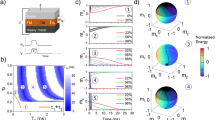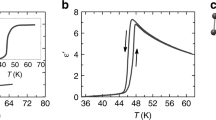Abstract
Conventional semiconductor devices use electric fields to control conductivity, a scalar quantity, for information processing. In magnetic materials, the direction of magnetization, a vector quantity, is of fundamental importance. In magnetic data storage, magnetization is manipulated with a current-generated magnetic field (Oersted–Ampère field), and spin current1,2 is being studied for use in non-volatile magnetic memories3,4. To make control of magnetization fully compatible with semiconductor devices, it is highly desirable to control magnetization using electric fields. Conventionally, this is achieved by means of magnetostriction produced by mechanically generated strain through the use of piezoelectricity5,6,7,8. Multiferroics9,10 have been widely studied in an alternative approach where ferroelectricity is combined with ferromagnetism. Magnetic-field control of electric polarization has been reported in these multiferroics using the magnetoelectric effect, but the inverse effect—direct electrical control of magnetization—has not so far been observed11. Here we show that the manipulation of magnetization can be achieved solely by electric fields in a ferromagnetic semiconductor, (Ga,Mn)As. The magnetic anisotropy, which determines the magnetization direction, depends on the charge carrier (hole) concentration in (Ga,Mn)As. By applying an electric field using a metal–insulator–semiconductor structure12,13,14, the hole concentration and, thereby, the magnetic anisotropy can be controlled, allowing manipulation of the magnetization direction.
This is a preview of subscription content, access via your institution
Access options
Subscribe to this journal
Receive 51 print issues and online access
$199.00 per year
only $3.90 per issue
Buy this article
- Purchase on Springer Link
- Instant access to full article PDF
Prices may be subject to local taxes which are calculated during checkout




Similar content being viewed by others
References
Slonczewski, J. C. Current-driven excitation of magnetic multilayers. J. Magn. Magn. Mater. 159, 1–7 (1996)
Berger, L. Emission of spin waves by a magnetic multilayer traversed by a current. Phys. Rev. B 54, 9353–9358 (1996)
Hosomi, M. et al. A novel nonvolatile memory with spin torque transfer magnetization switching spin-RAM. IEDM Tech. Dig. 473, 459–462 (2005)
Kawahara, T. et al. in ISSCC 2007 (eds Amiri, M et al.) 480–481 (IEEE Internat. Solid-State Circuits Conf., IEEE, 2007)
Schröder, K. Design parameters of a 3-dimensional ultrasonic pulse controlled memory device with single domain coherently magnetized cobalt, iron and nickel particles in a non-magnetic matrix. IEEE Trans. Magn. 10, 567–570 (1974)
Novosad, V. et al. Novel magnetostrictive memory device. J. Appl. Phys. 87, 6400–6402 (2000)
Goennenwein, S. T. B. et al. Piezo-voltage control of magnetization orientation in a ferromagnetic semiconductor. Phys. Status Solidi (RRL) 2, 96–98 (2008)
Overby, M., Chernyshov, A., Rokhinson, L. P., Liu, X. & Furdyna, J. K. GaMnAs-based hybrid multiferroic memory device. Appl. Phys. Lett. 92, 192501 (2008)
Tokura, Y. Multiferroics as quantum electromagnets. Science 312, 1481–1482 (2006)
Eerenstein, W., Mathur, N. D. & Scott, J. F. Multiferroic and magnetoelectric materials. Nature 442, 759–765 (2006)
Chu, Y.-H. et al. Electric-field control of local ferromagnetism using a magnetoelectric multiferroic. Nature Mater. 7, 478–482 (2008)
Ohno, H. et al. Electric-field control of ferromagnetism. Nature 408, 944–946 (2000)
Chiba, D., Yamanouchi, M., Matsukura, F. & Ohno, H. Electrical manipulation of magnetization reversal in a ferromagnetic semiconductor. Science 301, 943–945 (2003)
Chiba, D., Matsukura, F. & Ohno, H. Electric-field control of ferromagnetism in (Ga,Mn)As. Appl. Phys. Lett. 89, 162505 (2006)
Shen, A. et al. Epitaxy of (Ga,Mn)As, a new diluted magnetic semiconductor based on GaAs. J. Cryst. Growth 175–176, 1069–1074 (1997)
Tang, H. X., Kawakami, R. K., Awschalom, D. D. & Roukes, M. L. Giant planar Hall effect in epitaxial (Ga,Mn)As devices. Phys. Rev. Lett. 90, 107201 (2003)
Welp, U., Vlasko-Vlasov, V. K., Liu, X., Furdyna, J. K. & Wojtowicz, T. Magnetic domain structure and magnetic anisotropy in Ga1-x Mn x As. Phys. Rev. Lett. 90, 167206 (2003)
Liu, X., Sasaki, Y. & Furdyna, J. K. Ferromagnetic resonance in Ga1-x Mn x As: Effects of magnetic anisotropy. Phys. Rev. B 67, 205204 (2003)
Sawicki, M. et al. In-plane uniaxial anisotropy rotations in (Ga,Mn)As thin films. Phys. Rev. B 71, 121302 (2005)
Wang, K.-Y. et al. Spin reorientation transition in single-domain (Ga,Mn)As. Phys. Rev. Lett. 95, 217204 (2005)
Hamaya, K. et al. Magnetic anisotropy switching in (Ga,Mn)As with increasing hole concentration. Phys. Rev. B 74, 045201 (2006)
Pappert, K. et al. Transport characterization of the magnetic anisotropy of (Ga,Mn)As. Appl. Phys. Lett. 90, 062109 (2007)
Oiwa, A., Mitsumori, Y., Moriya, R., Słupinski, T. & Munekata, H. Effect of optical spin injection on ferromagnetically coupled Mn spins in the III–V magnetic alloy semiconductor (Ga,Mn)As. Phys. Rev. Lett. 88, 137202 (2002)
Hashimoto, Y., Kobayashi, S. & Munekata, H. Photoinduced precession of magnetization in ferromagnetic (Ga,Mn)As. Phys. Rev. Lett. 100, 067202 (2008)
Hayashi, T. et al. Anisotropy and Barkhausen jumps in diluted magnetic semiconductor (Ga,Mn)As. Physica B 284–288, 1175–1176 (2000)
Matsukura, F., Sawicki, M., Dietl, T., Chiba, D. & Ohno, H. Magnetotransport properties of metallic (Ga,Mn)As films with compressive and tensile strain. Physica E 21, 1032–1036 (2004)
Matsukura, F., Ohno, H., Shen, A. & Sugawara, Y. Transport properties and origin of ferromagnetism in (Ga,Mn)As. Phys. Rev. B 57, R2037–R2040 (1998)
Dietl, T., Ohno, H., Matsukura, F., Cibert, J. & Ferrand, D. Zener model description of ferromagnetism in zinc-blend magnetic semiconductors. Science 287, 1019–1022 (2000)
Abolfath, M., Jungwirth, T., Brum, J. & MacDonald, A. H. Theory of magnetic anisotropy in III1-x Mn x V ferromagnets. Phys. Rev. B 63, 054418 (2001)
Dietl, T., Ohno, H. & Matsukura, F. Hole-mediated ferromagnetism in tetrahedrally coordinated semiconductors. Phys. Rev. B 63, 195205 (2001)
Acknowledgements
We acknowledge discussion with M. Shirai. This work was supported in part by Grant-in-Aids from MEXT/JSPS, the GCOE Program at Tohoku University, the Research and Development for Next-Generation Information Technology Program (MEXT), and a Research Fellowship from JSPS.
Author Contributions D.C. and H.O. planned and supervised the study. D.C. grew the samples, made the devices, collected and analyzed data, and calculated magnetization switching. M.S. and F.M. investigated the magnetization characteristics of (Ga,Mn)As layers. Y. Nishitani investigated the transport characteristics of devices for the transport measurements and determined the dielectric constant of the ZrO2 gate insulators. Y. Nakatani performed the micromagnetic simulation. D.C., F.M. and H.O. wrote the manuscript. All authors discussed the results.
Author information
Authors and Affiliations
Corresponding author
Supplementary information
Supplementary Information
This file contains Supplementary Notes with Supplementary Figures S1-S3 (PDF 2152 kb)
Rights and permissions
About this article
Cite this article
Chiba, D., Sawicki, M., Nishitani, Y. et al. Magnetization vector manipulation by electric fields. Nature 455, 515–518 (2008). https://doi.org/10.1038/nature07318
Received:
Accepted:
Issue Date:
DOI: https://doi.org/10.1038/nature07318
This article is cited by
-
Strain-induced specific orbital control in a Heusler alloy-based interfacial multiferroics
NPG Asia Materials (2024)
-
Electrically manipulating magnetization reversal via energy band engineering
Science China Physics, Mechanics & Astronomy (2023)
-
Continuous manipulation of magnetic anisotropy in a van der Waals ferromagnet via electrical gating
Nature Electronics (2022)
-
Giant converse magnetoelectric effect in a multiferroic heterostructure with polycrystalline Co2FeSi
NPG Asia Materials (2022)
-
Local bifurcation with spin-transfer torque in superparamagnetic tunnel junctions
Nature Communications (2022)
Comments
By submitting a comment you agree to abide by our Terms and Community Guidelines. If you find something abusive or that does not comply with our terms or guidelines please flag it as inappropriate.



